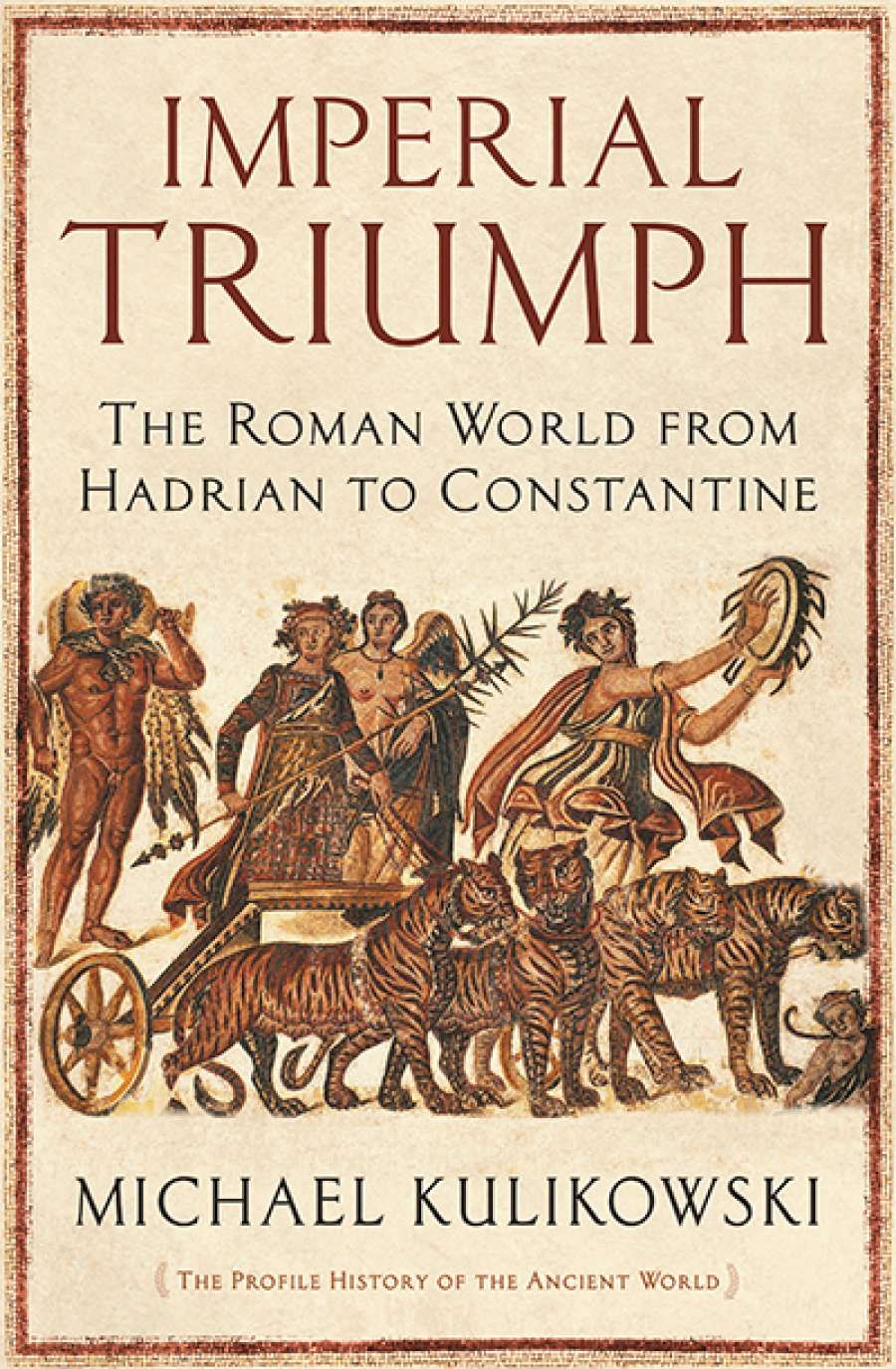
- Free Article: No
- Contents Category: History
- Custom Article Title: Christopher Allen reviews 'Imperial Triumph: The Roman world from Hadrian to Constantine' by Michael Kulikowski
- Book 1 Title: Imperial Triumph
- Book 1 Subtitle: The Roman world from Hadrian to Constantine
- Book 1 Biblio: Profile Books, $59.99 hb, 385 pp, 9780674659612
The external threats were many however, from tribal peoples in the north – gradually becoming more sophisticated through contact and exchange with Rome – to Persia in the east. This was the only comparable and rival imperial state with which Rome had to deal, first in the post-Hellenistic centuries of Parthian rule and then with the return of ethnically Persian rule with the Sasanians, who gave the Empire far more trouble. One of the virtues of Kulikowski’s book, indeed, is the way it situates Rome within a broader Eurasian context: this is less necessary in the earlier periods of Roman history, but indispensable in these later centuries.
There were also fundamental flaws in the Roman political system, the first of which was that the role of emperor – a figleaf used to avoid the hated word ‘king’ – had never been constitutionally defined. The ambiguous role of princeps as ostensibly a first among senatorial equals allowed Augustus to rule as a monarch while making a show of preserving republican traditions. This delicate balancing act, however, made a legal and thus legitimate process of succession impossible by definition, since the role of the princeps itself was inherently extra-legal, although, as Kulikowski shows, it was in practice composed of a package of special powers granted by the senate. At first it was assumed in a purely de facto way that the role would be hereditary through the Julio-Claudian family, but after that line failed it eventually came to be accepted that the senate could validate the claim of a sufficiently capable candidate.
Naturally, this arrangement was always going to work best when times were reasonably peaceful and when one competent emperor could prepare the way for an equally competent successor, a process that we see working reasonably well in the second century. When, in the third century, times were harder and the Empire was straining under wars or other crises on several fronts at once, and when an emperor died with no generally acceptable successor, it became common for multiple claimants to arise, nominated and backed by massive provincial armies. Episodes of civil war would ensue, often ended when one army decided their man was not going to win after all and murdered him. The average life expectancy of any candidate for imperial power in the middle of the third century was thus extremely short.
In contrast to this instability at the top, the general Roman system for promoting governmental officers was very effective, and tended to ensure that the most able reached the highest levels of responsibility. The cursus honorum was the name for the series of administrative offices or magistracies which had to be held in a defined order, from relatively modest office jobs to the consulship itself, in turn followed by proconsular appointment as a provincial governor as well as by a seat in the senate.
Certain offices could only be held by members of certain classes, but those classes could also be entered by a combination of successful service in lower positions, wealth, and patronage. In practice, the Roman system was extraordinarily open to new talent, to such an extent indeed that the upper classes of Rome underwent a constant evolution throughout this period: capable citizens from provincial lands became consuls, senators, and even emperors; and Roman citizenship was regularly extended as a reward to loyal non-Roman cities throughout the Empire, until finally Caracalla’s edict of 212 CE granted citizenship to all free men within the imperial territory.
 Hadrian’s Wall near Caw Gap, 2008 (photograph by Andrew Smith for the Geograph project via Wikimedia Commons)
Hadrian’s Wall near Caw Gap, 2008 (photograph by Andrew Smith for the Geograph project via Wikimedia Commons)
Just as important as changes in the ethnic composition of the Roman élite is what Kulikowski calls the equestrianisation of the Empire: although certain important and prestigious positions remain restricted to members of the senatorial class, more and more power falls to the equestrian order. And whereas the senatorial order were trained in the civic values and generalist skills required for the successive offices – whether military, legal, or administrative – of a great career, the new equestrian officials became a class of specialists: career soldiers, legal officers, and bureaucrats.
This is the new imperial system that culminates in the reforms of Diocletian and his successors. Kulikowski intriguingly suggests that Roman attempts to suppress Christianity might have been as much a consequence of a new centralising and universalising way of thinking as of any inherent hostility to the new religion. Persecution of the Christians, indeed, was abandoned when it was clear there were simply too many of them; and in due course Constantine, as we come to the end of this volume, finds that endorsement by the Christian god can be advantageous; the new centralised and bureaucratic state now becomes the vehicle for the spread of Christianity throughout the Empire.


Comments powered by CComment